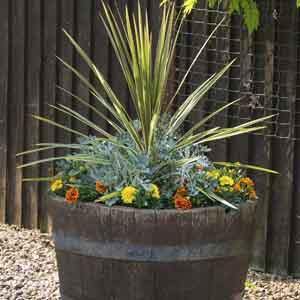Features
A practical and beautiful way to repurpose used wine and whisky barrels. The 100% oak half-barrel promises years of durability and adds a touch of rustic charm in the landscape. Great for mixed flower or vegetable plantings and big enough to feature a single shrub or dwarf tree.
Uses
Perfect for adding instant color to any location! They may be used to liven porches and patios.
Plant Feed
Fertilize regularly for best display.
Watering
Keep soil evenly moist.
Soil
Fertile, well-drained soil.
Basic Care Summary
Water as needed to keep soil evenly moist, especially in hot weather. Fertilize regularly for best
Planting Instructions
Start with a good quality, commercial potting soil. These are usually lighter in weight than topsoil, sterile and pest-free. Many are available with a mild starter fertilizer in the mix.
Select a container with a drainage hole or be prepared to drill holes for drainage if there are none.
Prepare the container by filling with potting soil up to 2” (5cm) from the rim of the planter. Remove the plant from its pot or pack. If plants are in a pack, gently squeeze the outside of the individual plant cell while tipping container to the side. If plant doesn't loosen, continue pressing on the outside of the container while gently grasping the base of the plant and tugging carefully so as not to crush or break the stem until the plant is released. If the plant is in a pot, gently grasp the base of the plant, tip it sideways and tap the outside of the pot to loosen. Rotate the container and continue to tap, loosening the soil until the plant pulls smoothly from the pot.
Make a small hole in the soil slightly larger than the root ball either by hand or using a trowel. Insert the plant into the hole and press soil firmly around the roots and just covering the root ball. When all the plants are potted, water thoroughly to settle the soil and give plants a good start.
Plan ahead for plants that get tall and require staking or support cages. It's best to install cages at planting time, before the foliage gets bushy. Vining plants require vertical space to grow, so provide a small trellis that allows the plant to grow freely and spread.
Watering Instructions
Plants in containers can dry out quickly, depending on the weather, and may need water more frequently than plants in the garden bed. Check the soil moisture with your finger. If the top 2-4” (5-10cm) of soil is dry, or plants are wilted, it is time to water.
Apply water at the soil level if possible to avoid wetting the foliage. Water the entire soil area until water runs out the base of the pot. This indicates that the soil is thoroughly wet.
Fertilizing Instructions
Fertilizers are available in many forms: granulated, slow-release, liquid feeds, organic or synthetic. Determine which application method is best for the situation and select a product with a nutritional balance designed to encourage blooming (such as 5-10-5).
Too much fertilizer can damage plants so it’s important to follow the package directions to determine how much, and how often, to feed plants.
Slow-release fertilizers are an especially good, care-free choice for container plants. A single application can often provide plants with the proper level of nutrition all season long.
Pruning Instructions
Most container plants can be pruned freely to maintain the desired size and shape. Keeping the foliage trimmed also keeps the plants looking neat and tidy, encourages the plant to develop more side-shoots and flowers, and reduces the demand for the plant to develop a larger root system. This is important since the roots are in a confined space.
Remove old flowers to keep plant looking healthy and prevent seed production that drains the plant’s energy at the expense of forming new flowers.
Some plants are grown only for their attractive foliage (such as coleus, dusty miller and flowering kale). The flowers are not particularly attractive so any buds that appear should be pinched off to keep the foliage looking its best.
| Category: | Container |
| Available Colors: | Assorted |
| Bloom Time: | Summer |
| Height Range: | 6-36" (15-91cm) |
| Space Range: | 6-24" (15-61cm |
| Lowest Temperature: | 30° to 40°F (-1° to 4°C) |
| Plant Light: | Sun to Part Shade |
| Companion Plants: | Potted Herbs, Patio Tree, Rose Planter |
| USDA Zone: | 10-12 |

